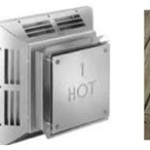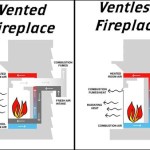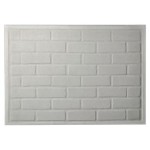Granite Fireplace Facing Kits: A Comprehensive Guide
Granite fireplace facing kits offer a durable and aesthetically pleasing solution for enhancing the visual appeal and functionality of a fireplace. These kits typically include pre-cut granite slabs designed to surround the fireplace opening, providing a finished and refined look. Granite, a naturally occurring igneous rock, is prized for its strength, resistance to heat and scratches, and unique patterns, making it an ideal material for fireplace surrounds.
The use of granite fireplace facing kits presents several advantages over other facing materials. Unlike materials like wood or drywall, granite is non-combustible and can withstand high temperatures without warping, melting, or catching fire. This inherent fire resistance contributes to increased safety within the home. Furthermore, granite’s density makes it relatively impervious to staining, which is especially important in a fireplace environment where soot and ash are common. Its durability ensures a long lifespan with minimal maintenance. These kits are designed for easier installation compared to custom-cut granite, streamlining the renovation or construction process.
This article provides a detailed examination of granite fireplace facing kits, covering various aspects including types of granite used, design considerations, installation procedures, maintenance requirements, and cost factors. The information aims to equip homeowners and contractors with the knowledge necessary to make informed decisions regarding the selection and application of granite fireplace facing kits.
Understanding the Variety of Granite
Granite is not a monolithic material; it encompasses a wide range of colors, patterns, and textures. These variations arise from differences in the mineral composition of the rock, originating from different geological formations and cooling processes. This diversity allows homeowners to select a granite type that perfectly complements their existing décor and personal preferences. Common granite colors used in fireplace facing kits include black, white, gray, brown, and various shades of red and green. Each color family offers a unique aesthetic. For example, black granite, such as Absolute Black or Black Galaxy, exudes a sophisticated and modern feel, while lighter granites, such as Bianco Antico or Kashmir White, can brighten a room and create a more open atmosphere.
Beyond color, the pattern and grain of the granite are crucial considerations. Some granites feature a consistent, uniform grain structure, while others exhibit swirling patterns, veining, or speckling. These patterns are often caused by the presence of different minerals within the stone. For instance, granite with large feldspar crystals might display a speckled appearance. Veining, common in granites like Crema Bordeaux, adds a sense of movement and visual interest. The choice of pattern should align with the overall design scheme of the room. A contemporary space might benefit from a granite with a simple, clean pattern, whereas a more traditional setting could accommodate a bolder, more intricate design.
The finish of the granite also plays a significant role in its overall look and feel. Polished granite features a high-gloss, reflective surface that enhances the stone’s natural colors and patterns. Honed granite, on the other hand, has a matte finish that provides a softer, more subtle look. Leathered granite offers a textured surface that adds depth and dimension. Each finish has its own advantages and disadvantages. Polished granite is easier to clean and more resistant to staining, but it can be more prone to scratches. Honed granite is more resistant to scratches but may require more frequent sealing. Leathered granite provides a unique tactile experience but can be more challenging to clean.
When selecting a granite type for a fireplace facing kit, it's essential to consider not only the aesthetic qualities but also the practical aspects. Some granites are more porous than others, making them more susceptible to staining. It's crucial to choose a granite that is suitable for the high-heat environment of a fireplace and to properly seal the stone to prevent staining and damage. Consulting with a stone supplier or contractor can provide valuable guidance in selecting the best granite type for a specific application.
Design and Installation Considerations
The design of a granite fireplace facing kit should be carefully considered to ensure it complements the architectural style of the home and the surrounding décor. Factors to consider include the size and shape of the fireplace opening, the desired style (e.g., modern, traditional, rustic), and the overall color palette of the room. The kit should be sized appropriately to fit the fireplace opening and provide adequate coverage around the firebox. The style of the granite should harmonize with the existing aesthetic. For instance, a sleek, minimalist design might call for a simple, unadorned granite facing, while a more ornate design might incorporate decorative elements or a more intricate granite pattern.
Before beginning the installation process, it is imperative to accurately measure the fireplace opening and the surrounding area. This will ensure that the granite slabs are cut to the correct dimensions and that the installation process proceeds smoothly. It is also important to prepare the surface onto which the granite will be installed. The surface should be clean, level, and structurally sound. Any existing facing material, such as brick or tile, should be removed. If the underlying surface is uneven, it should be leveled with a patching compound or mortar bed.
The installation of a granite fireplace facing kit typically involves the use of a thin-set mortar, which is a type of adhesive specifically designed for bonding stone materials. The mortar should be applied evenly to the back of the granite slabs and to the prepared surface. The slabs should then be carefully positioned and pressed firmly into place. Spacers can be used to maintain consistent grout lines between the slabs. It is crucial to ensure that the slabs are level and plumb during the installation process. A level and a plumb bob can be used to verify the alignment.
After the mortar has cured, the grout lines should be filled with a suitable grout. The grout should be chosen to complement the color of the granite and the overall design scheme. The grout should be applied evenly and allowed to dry completely. Once the grout has dried, it should be sealed to prevent staining and moisture damage. A high-quality grout sealer should be used, following the manufacturer's instructions. The sealing process should be repeated periodically to maintain the integrity of the grout.
For individuals with limited experience in masonry or tiling, professional installation is strongly recommended. Improper installation can lead to various problems, including loose slabs, uneven grout lines, and potential structural damage. A qualified contractor will have the expertise and tools necessary to ensure a successful and long-lasting installation.
Maintenance and Care of Granite Fireplace Facings
Proper maintenance is essential to preserving the beauty and longevity of a granite fireplace facing. While granite is a durable material, it is not entirely immune to damage. Regular cleaning and sealing are crucial to prevent staining, scratching, and other forms of wear and tear. The frequency of cleaning and sealing will depend on the type of granite, the level of use, and the environmental conditions.
For routine cleaning, a mild soap and water solution is typically sufficient. Harsh chemicals, abrasive cleaners, and scouring pads should be avoided, as they can damage the granite’s surface. A soft cloth or sponge should be used to gently wipe down the granite, removing any dust, dirt, or soot. After cleaning, the granite should be thoroughly dried with a clean cloth. Regular dusting with a dry cloth can also help to prevent the buildup of dirt and grime.
Sealing is an important step in protecting granite from staining and moisture damage. A high-quality granite sealer should be applied according to the manufacturer's instructions. The sealer penetrates the pores of the granite, creating a protective barrier that repels liquids and prevents stains from penetrating the surface. The frequency of sealing will depend on the porosity of the granite and the level of use. Some granites may require sealing every year, while others may only need to be sealed every few years.
In addition to regular cleaning and sealing, it’s important to address stains and spills promptly. If a spill occurs, it should be blotted up immediately with a clean cloth. If a stain develops, it may be necessary to use a specialized stain remover. There are various stain removers available specifically for granite, designed to remove different types of stains, such as oil-based stains, water-based stains, and rust stains. It is crucial to follow the manufacturer's instructions carefully when using a stain remover. In some cases, it may be necessary to contact a professional stone restoration company to remove stubborn stains.
For the long-term maintenance of granite fireplace facings, it's crucial to inspect the grout lines periodically. Cracks or crumbling grout should be repaired promptly to prevent water from seeping behind the granite slabs and causing damage. Grout repair can be done using a grout saw to remove the damaged grout and then applying new grout. The new grout should be sealed to prevent staining and moisture damage.
By following these maintenance guidelines, homeowners can ensure that their granite fireplace facing remains beautiful and functional for many years to come. Investing in proper care and maintenance is a worthwhile investment that will protect the value and aesthetic appeal of the fireplace.
Assessing the Cost of Granite Fireplace Facing Kits
The cost of granite fireplace facing kits can vary significantly depending on several factors, including the type of granite, the size and complexity of the kit, and the installation costs. Understanding these cost factors is essential for budgeting purposes and for making informed decisions about the selection and installation of a granite fireplace facing.
The type of granite is a major determinant of the cost. Rarer and more exotic granites, with unique colors and patterns, tend to be more expensive than commonly available granites. The cost of granite is typically measured per square foot, and prices can range from relatively affordable to significantly expensive, depending on the type of stone. For example, a common granite like Uba Tuba may be significantly less expensive than a rarer granite like Blue Bahia.
The size and complexity of the kit also impact the cost. Larger kits, which require more granite, will naturally be more expensive. Kits with intricate designs or custom cuts will also incur higher costs. The thickness of the granite slabs can also affect the price. Thicker slabs are generally more expensive but also more durable.
Installation costs represent a significant portion of the overall project cost. The cost of installation will vary depending on the complexity of the job, the location of the fireplace, and the labor rates in the area. Professional installation typically involves the removal of existing facing material, preparation of the surface, cutting and fitting the granite slabs, installing the slabs with mortar, grouting the seams, and sealing the grout. Some contractors may charge a flat fee for the entire project, while others may charge an hourly rate. It is advisable to obtain multiple quotes from different contractors to compare prices and services.
Beyond the initial cost, it is important to consider the long-term cost of ownership. Granite is a durable and low-maintenance material, which can result in cost savings over time. However, regular sealing and occasional repairs may be necessary. The cost of sealing materials and repair services should be factored into the overall cost assessment.
When evaluating the cost of a granite fireplace facing kit, it's essential to weigh the benefits against the costs. Granite offers a combination of durability, aesthetic appeal, and fire resistance, making it a valuable investment for enhancing the value and enjoyment of a home. By carefully considering the various cost factors and weighing the benefits, homeowners can make informed decisions that align with their budget and preferences.

Black Galaxy Granite Facing Kit Mantels Direct

Black Galaxy Granite Facing Kit Mantels Direct

Blue Pearl Granite Facing Kit Mantels Direct

Caledonia Granite Facing Kit Mantels Direct

Caledonia Granite Fireplace Surround Kit

Blue Pearl Granite Facing Kit Mantels Direct

Black Galaxy Granite Fireplace Surround Kit

Caledonia Granite Facing Kit Mantels Direct

Natural Stacked Stone Veneer Fireplace Ideas

Vermillion Brown Granite Fireplace Surround Kit
Related Posts








